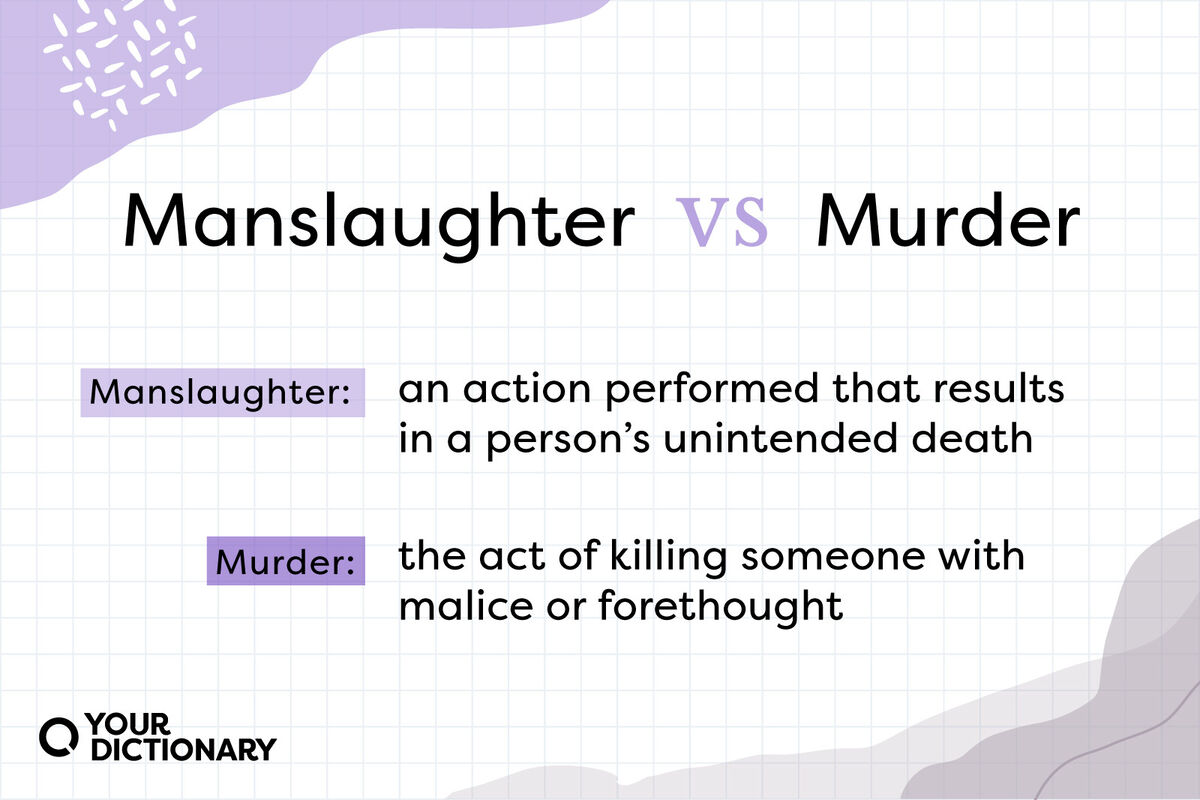
Murder and manslaughter both result in a person’s life ending prematurely, but these are legally distinct terms. With murder, the death is intentional, while manslaughter results in a person’s death without intent. These legal distinctions lead to different consequences for the perpetrator.
Difference Between Murder and Manslaughter: Intent
Murder and manslaughter are both types of homicide, which is the act of killing another person. But determining whether a killing is murder or manslaughter depends on the perpetrator’s intentions. Did they act in order to end another person’s life, or was the death an unintended consequence of reckless behavior?
- homicide (n) - the killing of one human being by another
- murder (n, v) - a form of homicide involving an action intended to result in a person’s death; the act of killing someone with malice aforethought
- manslaughter (n) - a form of homicide involving an action that results in a person’s death but is not the intent of that action
Manslaughter vs. Murder: Legal Consequences
Exact legal consequences will vary based on jurisdiction, but manslaughter is always considered a less severe crime, resulting in less severe punishment. A charge of manslaughter may result in:
- A prison sentence (a few years to a decade)
- Supervised release
- Parole
A murder charge comes with more severe sentencing, including:
- Decades of prison
- Life sentence(s) (with or without parole)
- The death penalty
Degrees of Manslaughter
A prosecutor can charge a defendant with one of two different forms, or degrees, of manslaughter: voluntary manslaughter and involuntary manslaughter.
Voluntary Manslaughter
The difference between voluntary manslaughter and second-degree murder is quite nuanced. Neither act is premeditated, but second-degree murder involves a defendant knowing that their actions will end another person’s life.
Voluntary manslaughter includes cases where the perpetrator loses control due to provocation or temporary emotional instability. Examples of voluntary manslaughter include:
- Believing that one’s life is in danger and reacting in a way that takes someone’s life (known as imperfect self-defense)
- Being bullied into an emotional state in which someone reacts by killing the bully
- Having a mental illness that causes delusions of harm by others, resulting in the defendant lashing out against others
- Becoming emotionally distraught at the news of a partner’s affair and killing them in the same moment
Involuntary Manslaughter
Involuntary manslaughter is known as the least culpable homicide charge. People who commit involuntary manslaughter have no intention of killing or even harming another person. However, their reckless or negligent actions did lead to another person’s death.
Many cases of involuntary manslaughter fall under either intoxication or vehicular manslaughter charges. In some states, involuntary manslaughter is classified as a misdemeanor, which may result in a lighter sentence. Examples of involuntary manslaughter include:
- Accidentally hitting a pedestrian with your car while driving and texting
- A doctor whose insufficient attention or care leads to the death of a patient
- Accidentally leaving a young child in a hot car
- Incorrectly cleaning a loaded gun, causing it to fire out the window and kill a passerby
- Dealing a fatal amount of drugs to an addict, indirectly causing them to overdose
Degrees of Murder
A prosecutor who wants to charge a suspect with murder must gather evidence to prove that they acted with the premeditated intention to kill the victim. Depending on how much evidence they have, the court can charge the suspect with two degrees of murder (although three states also include third-degree as a possible charge).
First-Degree Murder
Someone who has committed first-degree murder acted with premeditation and the full intention to end another person’s life. It is a willful, deliberate act, and it’s the most serious charge of murder.
Cases that might end in a first-degree murder charge include:
- Stalking someone in order to kill them
- Bringing a weapon to a public place with the intention of killing someone
- Attacking someone with enough violence to show malice and intention of killing them
- Hiring another person to kill a victim
Felony Murder Rule
The felony murder rule allows for a first-degree murder charge for a defendant involved in the incidental death of a person during a dangerous crime. The rule of transferred intent mandates that the intention of committing a felony transfers to the intention of murder. Examples of felony murder include:
- Committing arson to a house that results in someone’s death
- Killing a homeowner in the act of robbing their house
- Abusing a spouse so severely that they die
- Kidnapping a person who later dies of injuries from the kidnapping
- Stealing a car with a passenger inside, then getting into an accident that takes their life
A prosecutor can try for a felony murder change in these situations, but most of the time, prosecutors have more evidence for second-degree murder than for felony murder.
Second-Degree Murder
While first-degree murder involves planning and intent, second-degree murder is defined as a spontaneous act of homicide. Most second-degree charges still require evidence of the defendant’s intent to end the other person’s life. Examples of situations involving second-degree murder include:
- Having a verbal dispute with someone that escalates physically, resulting in an impulsive act that kills the other person
- A case of road rage that causes one person to kill the other person
- Driving a car into a crowd (an act classified as depraved heart murder)
- Attacking someone with the intent of hurting them, but accidentally killing them instead (known as reckless disregard)
While these may overlap with involuntary manslaughter, notice that nearly every situation occurs in the heat of the moment with high emotions.
The Criminal Justice System
The difference between murder and manslaughter has everything to do with intent. However, in the American criminal justice system, it also has to do with legal argumentation, evidence and jury conviction.